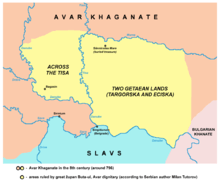Butaul
Butaul (also spelled Buta-ul, with possible meaning "the son of Buta"[1]) is a name mentioned in an inscription contained in a treasure trove of gold artifacts found in 1799 in Groß Sankt Nikolaus (Romanian: Sânnicolau Mare) in northern Banat (then under administration of Habsburg Monarchy, today in Timiş County in western Romania). According to various interpretations of the inscription, Butaul was an župan,[2] a sort of local chieftain.
The inscription
Buta-ul and Buyla are names preserved by an inscription on one of the vessels found in the hoard. The inscription is written in the Greek alphabet and reads:
- BOYHΛA.ZOAΠAN.TECH.ΔYΓΕTOIΓH.BOYTAOYΛ.ZΩAΠAN.TAΓPOΓH.HTZIΓH.TAICH
- (Transliteration: bouēla zoapan tesē dygetoigé boutaoul zōapan tagrogē ētzigē taisē).[3]
The language of the inscription is unknown. While there is no consensus as to the meaning of the inscription, there is general agreement that Buta-ul and Buyla are personal names from a Turkic language, and that both are identified as holding the title of župan. Other very short inscriptions found on the artifacts there are in a runiform script and also likely to be in a Turkic language, but these are very brief and have not been deciphered.[4]
Interpretations
Various sources provided different interpretations of the inscription. According some opinions, inscription was written by a people whose local leaders had Turkic names and bore Slavic titles.[5] According to other opinions, form ZOAΠAN could be read as "čaban", so BOYTAOYΛ.ZΩAΠAN would mean "son of Buta from the breed of čaban".[6]

According to one interpretation, Buyla was the grand duke of two Getae lands of the Tisa, while Buta-ul was the duke of the Tagro and Etzi lands of the Tisa.[8] According to other interpretation, Župan Buila (Buyla) was prince of Dügetoigi, while Grand Župan Butaul was prince of Tagrogi and Itschigi (Utschugi).[8] Another interpretation states that Butaul was župan of Tagroges, Iazyges, the peoples of the Tisa.[9] Another translation states that Bela (Buyla) was župan of the Tisa, while Butaul was župan of the Iazyges.[10] According to Serbian historian Milan Tutorov, grand župan Buta-ul was ruler of two Getae lands, Targorska and Eciska and across the Tisa.[7] Tutorov claims that "Getae land" was designation for present-day Banat, while area "across the Tisa" is present-day Bačka.[7]
According to Tutorov, Buta-ul was an Avar noble who had a traditional Slavic ruler's title - the "great župan" (rendering veliki župan).[7] Tutorov also speculates that the Treasure of Groß Sankt Nikolaus was probably buried by Buta-ul in 796, when Pippin, the son of Frankish ruler Charlemagne, penetrated with his army into the centre of Avar caganate near the river Tisa.[7] It is assumed that Buta-ul buried his treasure in great hurry before the Frankish army arrived,[7] since the treasure was buried only half metre deep in the ground.[7]
See also
- Banat
- Buyla
- History of Vojvodina
- Rulers of Vojvodina
- Treasure of Nagyszentmiklós
References
- ↑ Acta linguistica Academiae Scientiarum Hungaricae, Том 21, Magyar Tudományos Akadémia, 1971, page 37.
- ↑ From Daēnā to Dîn: Religion, Kultur und Sprache in der iranischen Welt ; Festschrift für Philip Kreyenbroek zum 60. Geburtstag, Christine Allison, Anke Joisten-Pruschke, Antje Wendtland, Otto Harrassowitz Verlag, 2009, page 5.
- ↑ Francis Dvornik, "Deux inscriptions gréco-bulgares de Philippes", Bulletin de correspondance hellénique, 1928 Vol. 52 no. 52, pp. 125-147 , accessed Oct. 10, 2011
- ↑ András Róna-Tas, Hungarians and Europe in the early Middle Ages (Central European University Press, 1999; ISBN 963-9116-48-3), pp. 131-132
- ↑ Hungarians and Europe in the early Middle Ages: an introduction to early Hungarian history, András Róna-Tas, Central European University Press, 1999, page 132.
- ↑ Linguistica, Том 27, Raziskovalna skupnost Slovenije, 1987, page 121.
- ↑ 7.0 7.1 7.2 7.3 7.4 7.5 7.6 Milan Tutorov, Banatska rapsodija - istorika Zrenjanina i Banata, Aurora, Novi Sad, 2001, pages 164-165.
- ↑ 8.0 8.1 Die Inschriften des Schatzes von Nagy-Szentmiklós, Robert Göbl, András Róna-Tas, Verlag der Österreichischen Akademie der Wissenschaften, 1995, page 19.
- ↑ Geschichte des Osmanischen reiches, Joseph Hammer-Purgstall (Freiherr von), C. A. Hartleben, 1828, page 726.
- ↑ Mélanges russes tirés du Bulletin de l'Académie impériale des sciences de St. Pétersbourg, Том 2, Imperatorskai︠a︡ akademīi︠a︡ nauk (Russia), Académie, 1855, page 277.
External links
![]() Media related to Buta-ul at Wikimedia Commons
Media related to Buta-ul at Wikimedia Commons